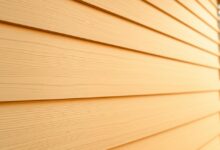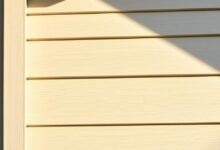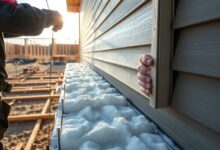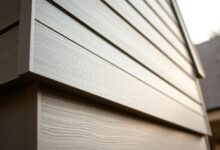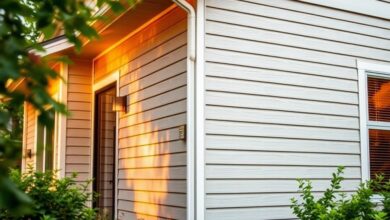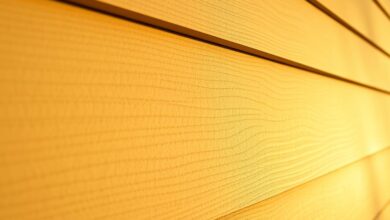Insulated Siding: Improve Home Insulation and Comfort
Homeowners are always searching for ways to make their homes more energy efficient and cozy. Insulated siding is a modern choice that does just that. It makes your house look great and keeps the weather out.
Adding insulated siding helps your home keep warmth in winter and cool in summer. This means you’ll use less energy and save money. It’s a smart choice for a better, more comfortable home.
Key Takeaways
- Insulated siding improves home energy efficiency.
- It provides a durable and long-lasting exterior finish.
- Homeowners can enjoy lower energy bills.
- A more comfortable living space is achieved.
- Insulated siding is a modern exterior finishing solution.
What Is Insulated Siding and How Does It Work?
Insulated siding adds insulation to your siding, cutting down on heat loss. It makes your home warmer in winter and cooler in summer. This is thanks to its design, which includes insulation between the siding and the wall.
The Science Behind Insulated Siding
Insulated siding stops heat from escaping through gaps. Insulated siding creates a solid insulation layer around your home. This boosts energy efficiency and keeps your home at a steady temperature.
R-Value and Energy Efficiency
The R-value shows how well a material keeps heat out. Insulated siding has a good R-value, helping your home save energy. For example, some products have an R-value of 3 or 4, which is quite effective.
| Material | R-Value |
|---|---|
| Vinyl Insulated Siding | 3.5 |
| Fiber Cement Insulated Panels | 4.2 |
| Foam Backed Siding | 4.5 |
Benefits of Insulated Siding for Better Insulation
Choosing insulated siding brings many advantages for your home. It helps keep your home warm in winter and cool in summer. This makes your home more comfortable and saves on energy costs.
Energy Cost Savings
Insulated siding can help you save money on your energy bills. It keeps your home’s temperature steady, so you don’t need to use as much heat or air conditioning. This can lead to big savings over time.
Noise Reduction Properties
It also makes your home quieter. The insulation blocks out outside noises, making your home a peaceful place to live. This is great for homes near busy streets or highways.
Improved Structural Integrity
Insulated siding also makes your home stronger. It adds a protective layer against weather damage. This helps keep your home safe and looking good for years to come.
Enhanced Curb Appeal
Lastly, it makes your home look better. Insulated siding comes in many styles and colors. You can pick one that matches your home’s look, making it more attractive to everyone who sees it.
Types of Insulated Siding Materials
Insulated siding comes in different types, each with its own benefits. Homeowners can pick from various materials. These materials aim to boost energy efficiency, durability, and look.
Vinyl Insulated Siding
Vinyl insulated siding is a favorite among homeowners. It’s known for its durability and low maintenance. This siding combines vinyl with insulation, making it energy-efficient and weather-resistant.
It comes in many colors and styles. This makes it easy to match with any home’s look.
Fiber Cement Insulated Panels
Fiber cement insulated panels are strong and last long. They’re made from cement, sand, and cellulose fibers. This mix gives them great durability and protection against pests and fire.
When you add insulation, these panels become very energy-efficient. They make a great exterior cladding system.
Foam Backed Options
Foam-backed insulated siding boosts a home’s energy efficiency. It has a foam backing on the siding material’s back. This adds more insulation and cuts down on heat transfer.
Foam-backed siding is available in materials like vinyl and fiber cement. This gives homeowners more choices for their exterior cladding.
Preparing for Insulated Siding Installation
Getting ready for insulated siding installation is key. It makes the process smooth and efficient. Before starting, know the steps to prepare your home for this upgrade.
Tools and Materials Needed
First, gather the right tools and materials. You’ll need a tape measure, utility knife, hammer, and insulated siding panels. Make sure you have all necessary components, like starter strips, J-channel, and siding nails, to avoid delays.
Measuring Your Home’s Exterior
Accurate measurements are vital. Measure each wall’s height and width, noting any obstructions like windows and doors. Calculate the total square footage to buy enough siding. Add 10% for waste.
Removing Old Siding
Removing the old siding is the next step. This can be hard work and needs care to avoid damage. Use a pry bar to remove the old siding, and save reusable materials like nails or flashing.
Inspecting and Repairing Wall Sheathing
After removing the old siding, check the wall sheathing for damage or rot. Fix any damaged areas with new sheathing material. This ensures a solid base for your new siding and keeps your home strong.
Step-by-Step Installation Guide
Homeowners can install insulated siding with the right tools and knowledge. This guide will help you through each step. It ensures your home becomes more energy-efficient and looks great.
Installing the Starter Strip and House Wrap
The first step is to install the starter strip and house wrap. The starter strip helps the siding stay level and attached. Measure your home’s perimeter and cut the starter strip to fit.
Then, apply the house wrap. Overlap the edges by 6 inches to keep water out. This layer protects your home from the weather.
Attaching Insulation Boards
Next, attach the insulation boards to your home’s exterior. These boards are key for keeping your home warm. Make sure they fit tightly together without gaps.
Securing Siding Panels
After the insulation boards are in place, start securing the siding panels. Begin at the bottom and work up. Each panel should fit snugly against the one below it.
Use the right fasteners to attach the panels to the wall. Follow the manufacturer’s instructions for spacing.
Working Around Windows and Doors
Installing siding around windows and doors can be tricky. To get a professional look, measure and cut the siding carefully. Use a utility knife or saw, depending on the material.
Make sure the siding fits tightly around these areas. This keeps your installation strong.
Finishing Touches and Trim Work
The last step is adding finishing touches and trim work. Install J-channel around windows and doors. Then, add trim to cover any exposed edges.
This not only makes your home look better but also protects it from the weather.
Conclusion
Choosing the right siding for your home is very important. It can make a big difference in how energy-efficient and comfortable it is. Insulated siding is a great choice because it saves on energy costs and makes your home stronger.
Learning about the different types of insulated siding and how to install it can make your home better. It makes your home more comfortable and helps the environment. Plus, it can lower your utility bills.
Thinking about improving your home? Insulated siding is a smart choice. It improves insulation, reduces noise, and makes your home look better. It’s a good investment for anyone wanting to make their home better and save money in the long run.
